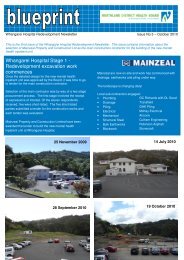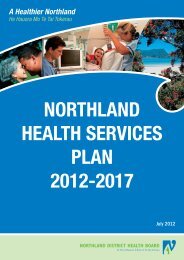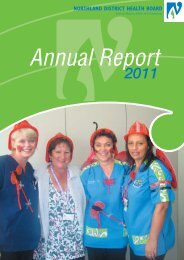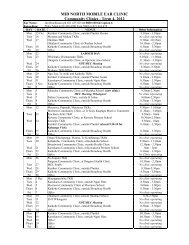E22 A4 Annual Report 2010 FP.indd - Northland District Health Board
E22 A4 Annual Report 2010 FP.indd - Northland District Health Board
E22 A4 Annual Report 2010 FP.indd - Northland District Health Board
Create successful ePaper yourself
Turn your PDF publications into a flip-book with our unique Google optimized e-Paper software.
the pilot is to improve the integration of care between the NGO and<br />
the district health board’s mental health service, and to explore the<br />
potential of NGO reporting to the Ministry of <strong>Health</strong> being undertaken<br />
by the district health board via JADE.<br />
• Picture Archiving and Communications System (PACS) Expansion<br />
Inpatient and outpatient radiology services are provided at four<br />
<strong>Northland</strong> DHB’s sites – Whangarei, Dargaville, Bay of Islands and<br />
Kaitaia. Radiological services for patients referred from the community<br />
are also provided at these sites.<br />
PACS was introduced in June 2008 to Whangarei, Dargaville, Bay of<br />
Islands and Kaitaia Hospitals and has seen the use of fi lm processing<br />
becoming obsolete. Recently, the PACS link to the Auckland DHB<br />
was extended to Kaitaia Hospital, improving clinical access to x-rays<br />
for patients transferring to Auckland City Hospital or Starship for<br />
treatment.<br />
• Regional Information Strategy<br />
In December 2009, the northern district health boards, together<br />
with a wide range of sector stakeholders, developed the Regional<br />
Information Strategy for <strong>2010</strong> to 2020 (RIS10-20). The strategy<br />
supports the transformation to new models of care and underpins the<br />
development of a person-centre model to achieve better, sooner, more<br />
convenient health care.<br />
Safe Medication Management Programme<br />
Medication is one of the most common therapeutic interventions used in<br />
the health care system, and medication errors in hospitals or the community<br />
are common. Approximately 1.6% of people admitted to hospital may<br />
experience an adverse medication event. Of these events, the majority are<br />
preventable and occur inside hospitals. Preventable adverse events have a<br />
signifi cant impact on consumers. About 3.1% result in death and 8.3% in<br />
permanent disability.<br />
<strong>Northland</strong> DHB has introduced strategies proven to be effective for reducing<br />
the rate of errors in medication management. They include: pharmacy<br />
software; reconfi guration of medication rooms and implementation of a<br />
new patient medication chart on 6 April <strong>2010</strong>.<br />
Value for Money (VfM) and Productivity Increase<br />
<strong>Northland</strong> DHB established a VfM steering group to oversee and support<br />
VfM projects, report benefi ts and ensure ongoing benefi ts are imbedded into<br />
the organisation. Launched in 2009, the aim of the group is to encourage<br />
staff to submit cost savings and effi cient project and ideas.<br />
Working through a number of great ideas in areas including electricity<br />
consumption, use of motor vehicles and procurement reviews, the district<br />
health board has saved over $1,200,000.<br />
Violence Intervention Programme<br />
The violence intervention programme screening project is currently being<br />
implemented at Whangarei Hospital’s emergency department and maternity<br />
service and Kaitaia Hospital. During the next two years, the programme<br />
will be rolled out within all areas of the district health board.<br />
Family violence intervention training is now mandatory for all district health<br />
board services and departments.<br />
Whangarei Hospital’s Site Master Plan<br />
Strong progress continues with the Whangarei Hospital development<br />
following the Minister of <strong>Health</strong>’s approval of our stage one business case<br />
to build a new mental health inpatient unit. Principal consultants for the<br />
multi-million dollar building programme have been selected.<br />
The developed design for the new 25 bed mental health unit at Whangarei<br />
Hospital was approved by the <strong>Northland</strong> DHB <strong>Board</strong> at its meeting held<br />
on 21 June <strong>2010</strong>.<br />
The main building contractor is expected to be appointed in late September<br />
and works will commence on site at Whangarei Hospital in October <strong>2010</strong>.<br />
The building is expected to be completed and operational by December<br />
2011.<br />
PUBLIC AND POPULATION HEALTH POINTS<br />
Emergency Planning and Disease Outbreaks<br />
Following the World <strong>Health</strong> Organisation declared H1N1 pandemic<br />
infl uenza event, <strong>Northland</strong> DHB successfully contained and managed<br />
the H1N1 outbreak in <strong>Northland</strong> during the winter of 2009. Work is<br />
continuing on the development of the Maori component of the <strong>Northland</strong><br />
DHB pandemic plan.<br />
A tornado hit Kaitaia Hospital on Saturday, 4 July <strong>2010</strong>. It damaged<br />
roofi ng on the old boiler house and shattered glass in the building. The<br />
boiler room roof landed on the main hospital roof, damaging it. The<br />
general practitioner waiting room areas had considerable damage done to<br />
the ceiling tiles. The glass panel in the fi rst exit doors next to the cafeteria<br />
was damaged along with the windows at the front entrance to the hospital.<br />
There were patients and children in the waiting area, but fortunately no one<br />
was hurt.<br />
On 30 October 2009, all theatres were closed as a result of a signifi cant<br />
power cut experienced through out <strong>Northland</strong> and Auckland. All elective<br />
surgery was cancelled as a consequence and patients were rescheduled.<br />
In January <strong>2010</strong>, dry conditions prevailed in <strong>Northland</strong> causing less<br />
than average monthly rainfall resulting in low river and stream levels and<br />
extreme soil moisture defi cits. Drought conditions continued to worsen<br />
and the Far North <strong>District</strong> Council placed area water restrictions in Kaitaia<br />
directly affecting Kaitaia Hospital. <strong>Northland</strong> DHB activated its incident<br />
management team to monitor community health concerns. The team stood<br />
down on 1 June, following the lifting of water restrictions by the district<br />
council.<br />
In March <strong>2010</strong>, <strong>Northland</strong> DHB’s medical offi cer of health notifi ed<br />
<strong>Northland</strong>ers of a measles outbreak in <strong>Northland</strong> area. There had been<br />
thirty two reported cases of measles (fi ve laboratory confi rmed) in the<br />
Hokianga since the middle of February <strong>2010</strong>.<br />
All cases, except for one, were directly associated with an extended family<br />
group in the Hokianga whose children are largely unvaccinated and are<br />
home-schooled. Most cases were unwell, with one child admitted to<br />
hospital.<br />
High Five for clean hands<br />
In 2007, the <strong>Northland</strong> <strong>District</strong> <strong>Health</strong> <strong>Board</strong> with support from<br />
representatives from <strong>Northland</strong>’s schools and early childhood centers<br />
launched a <strong>Northland</strong>-wide project for children aged 0 – 12 years focusing<br />
on the lifelong importance of good hand hygiene.<br />
The goal of the programme was to effectively spread the message<br />
throughout <strong>Northland</strong> that thoroughly washing and drying hands is one of<br />
the most signifi cant things that children and their families can do to prevent<br />
the spread of illnesses.<br />
In August 2009, the Ministry of <strong>Health</strong> adopted the programme and rolled<br />
it out over 6,000 schools and preschools throughout New Zealand to<br />
support hygiene activities in local communities and in response to Novel A<br />
H1N1 09 pandemic.<br />
In response, <strong>Northland</strong> DHB’s public health promotion unit launched the<br />
second phase of the programme involving the unveiling of vehicle signage<br />
and billboards. Each vehicle and billboard incorporates the vibrant ‘High<br />
5 for Clean Hands’ theme.<br />
SCHOOL AND COMMUNITY FOCUSED ACTIONS<br />
<strong>Health</strong> Assessment of Year 9 Children in Decile 1 and 2 Schools<br />
The new school based health assessment programme for Year 9 children in<br />
Decile 1 and 2 schools began in May <strong>2010</strong>. The overall purpose of the<br />
programme is to identify health issues, improve students’ access to primary<br />
health care and to ensure that appropriate and timely referrals are made in<br />
order to improve youth health and reduce inequalities.<br />
The programme’s objectives are to appropriately plan for, resource and<br />
25






